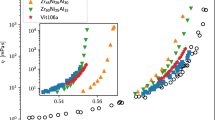Abstract
This article reviews recent advances in understanding amorphous glassy states in dense colloidal suspensions with or without short-range interparticle attractions. Experiments, theory, and simulation show that two kinds of glassy states are possible, dominated respectively by repulsion and attraction. Under suitable conditions, a small change in the interparticle potential can lead to a transition between these two kinds of colloidal glasses that entails sharp changes in material properties such as the shear modulus. This may provide novel routes for fine-tuning the properties of industrial pastes and slurries.
Similar content being viewed by others
References
U. Bengtzelius, W. Götze, and A. Sjölander, J. Phys. C 17 (1984) p. 5915.
P.N. Pusey and W. van Megen, Nature 320 (1986) p. 340.
P.N. Pusey and W. van Megen, Phys. Rev. Lett. 59 (1987) p. 2083.
The MCT literature is mostly very mathematical. For a less extensively mathematical review, see W. Götze and Sjölander, Rep. Prog. Phys. 55 (1992) p. 241. For brief critical introductions, see K. Kawasaki and B. Kim, J. Phys.: Condens. Matter 14 (2002) p. 2265; and M.E. Cates, “Arrest and Flow of Colloidal Glasses,” arXiv.org e-print archive, http://arxiv.org/abs/cond-mat/0211066 (accessed December 2003).
W. van Megen and S.M. Underwood, Phys. Rev. E 49 (1994) p. 4206.
E.R. Weeks, J.C. Crocker, A.C. Levitt, A. Schofield, and D.A. Weitz, Science 287 (2000) p. 627.
W.C.K. Poon, J.S. Selfe, M.B. Robertson, S.M. Ilett, A.D. Pirie, and P.N. Pusey, J. Phys. II 3 (1993) p. 1075.
For a review of this model system, see W.C.K. Poon, J. Phys.: Condens. Matter 14 (2002) p. R859.
J. Bergenholtz and M. Fuchs, Phys. Rev. E 59 (1999) p. 5706.
L. Fabbian, W. Götze, F. Sciortino, P. Tartaglia, and F. Thiery, Phys. Rev. E 59 (1999) p. R1347; L. Fabbian, W. Götze, F. Sciortino, P. Tartaglia, and F. Thiery, Phys. Rev. E 60 (1999) p. 2430.
K.N. Pham, A.M. Puertas, J. Bergenholtz, S.U. Egelhaaf, A. Moussaïd, P.N. Pusey, A.B. Schofield, M.E. Cates, M. Fuchs, and W.C.K. Poon, Science 296 (2002) p. 104.
A.M. Puertas, M. Fuchs, and M.E. Cates, Phys. Rev. Lett. 88098301 (2002).
K.N. Pham, S.U. Egelhaaf, P.N. Pusey, and W.C.K. Poon, “Glasses in Hard Spheres with Short-Range Attraction,” arXiv.org e-print archive, http://arxiv.org/abs/cond-mat/0308250 (accessed December 2003).
T. Eckert and E. Bartsch, Phys. Rev. Lett. 89125701 (2002).
S.H. Chen, W.R. Chen, and F. Mallamace, Science 300 (2003) p. 619.
J. Grandjean and A. Mourchid, in Self-Assembled Nanostructured Materials, edited by Y. Lu, C.J. Brinker, M. Antonietti, and C. Bai (Mater. Res. Soc. Symp. Proc. 775, Warrendale, PA, 2003) p. 231.
K. Dawson, G. Foffi, M. Fuchs, W. Gotze, F. Sciortino, M. Sperl, P. Tartaglia, Th. Voigtmann, and E. Zaccarelli, Phys. Rev. E 63011401 (2001).
F. Sciortino, Nat. Mater. 1 (2002) p. 145.
M. Sperl and W. Gotze, Phys. Rev. E 66011405 (2002).
F. Sciortino, P. Tartaglia, and E. Zaccarelli, “Logarithmic Relaxation in Dense Short-Ranged Attractive Colloids,” arXiv.org e-print archive, http://arxiv.org/abs/cond-mat/ 0304192 (accessed December 2003).
E. Zaccarelli, G. Foffi, F. Sciortino, and P. Tartaglia, Phys. Rev. Lett. 911083101 (2003).
K.S. Schweizer and E.J. Saltzman, J. Chem. Phys. 119 (2003) p. 1181.
G. Szamel, Phys. Rev. Lett. 90228301 (2003). However, using simulated (rather than analytic) structure factors in standard mode coupling theory gives fg = 0.546; G. Foffi, W. Gotze, F. Sciortino, P. Tartaglia, and Th. Voigtmann, “Alpha-Relaxation Processes in Binary Hard-Sphere Mixtures,” arXiv.org e-print archive, http://arxiv.org/abs/cond-mat/ 0309007 (accessed December 2003).
E. Donth, J. Phys. 16 (1996) p. 1189; D. Long and F. Lequeux, Eur. Phys. J. E 4 (2001) p. 371; S. Merabia and D. Long, Eur. Phys. J. E 9 (2002) p. 195; J.P. Garrahan and D. Chandler, Phys. Rev. Lett. 89 035704 (2002).
L. Cipelletti, H. Bissig, V. Trappe, P. Ballesta, and S. Mazoyer, J. Phys.: Condens. Matter 15 (2003) p. S257.
M. Fuchs and M.E. Cates, Faraday Discuss. 123 (2003) p. 267; M. Fuchs and M.E. Cates, Phys. Rev. Lett. 89 248304 (2002).
S.M. Fielding, P. Sollich, and M.E. Cates, J. Rheol. 44 (2000) p. 323.
P.N. Segre, V. Prasad, A.B. Schofield, and D.A. Weitz, Phys. Rev. Lett. 86 (2001) p. 6042.
W.C.K. Poon, Faraday Discuss. 123 (2003) p. 95; K. Kroy, M.E. Cates, and W.C.K. Poon, “A cluster mode-coupling to weak gelation in attractive colloids,” arXiv.org e-print archive, http://arxiv.org/abs/cond-mat/0310566 (accessed January 200).
E. Stiakakis, D. Vlassopoulos, B. Loppinet, J. Roovers, and G. Meier, Phys. Rev. E 66051804 (2002).
C. Beck, W. Hartl, and R. Hempelmann, J. Chem. Phys. 111 (1999) p. 8209.
Rights and permissions
About this article
Cite this article
Poon, W.C.K. Colloidal Glasses. MRS Bulletin 29, 96–99 (2004). https://doi.org/10.1557/mrs2004.35
Published:
Issue Date:
DOI: https://doi.org/10.1557/mrs2004.35




